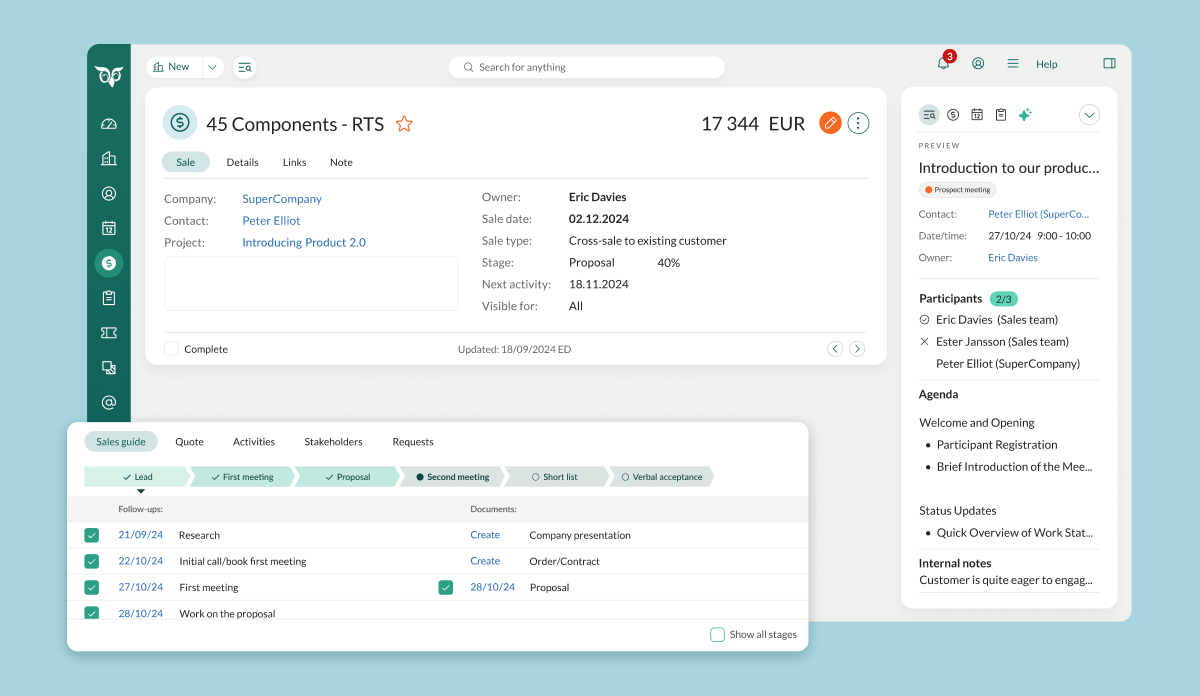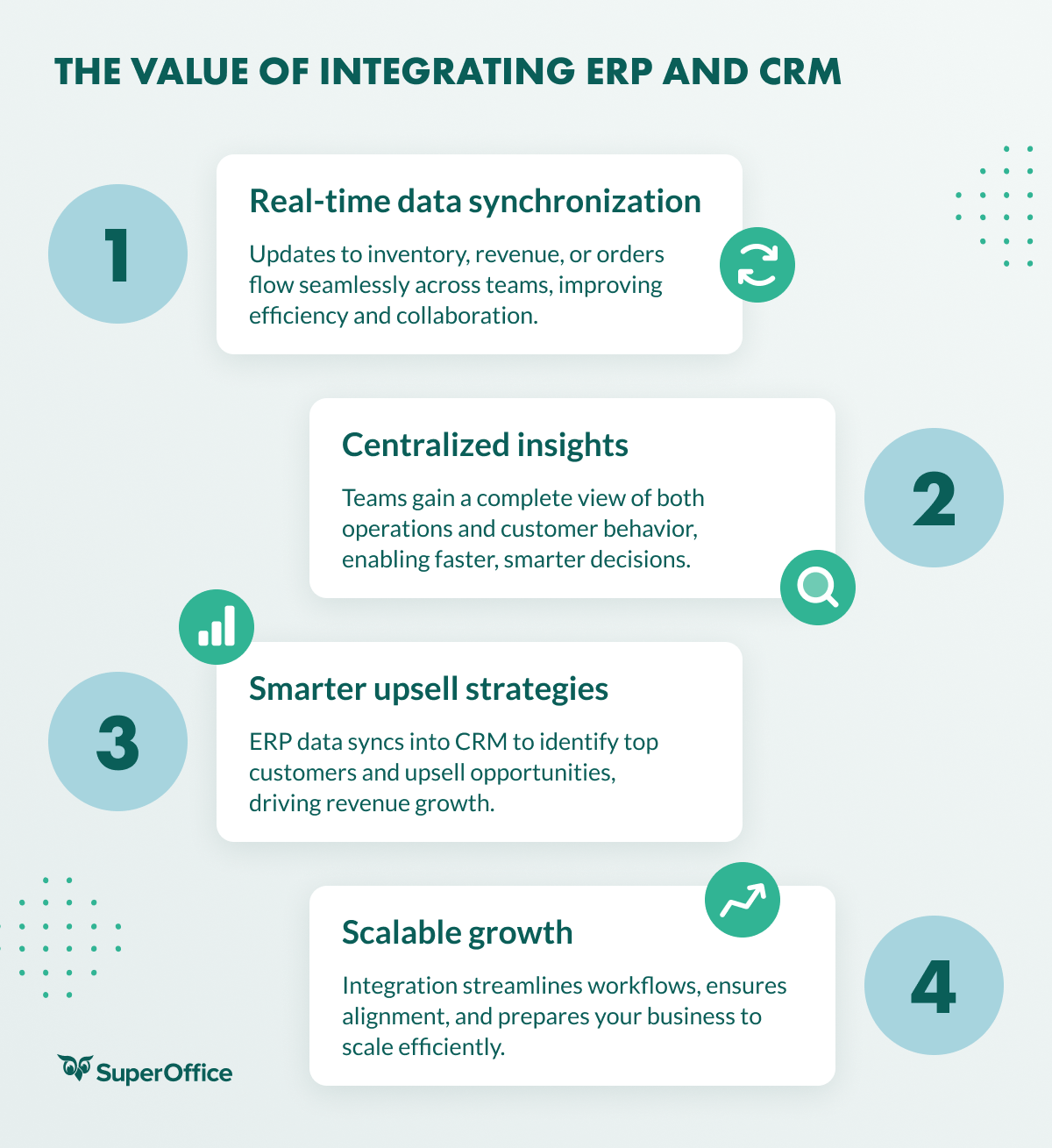If you’re managing your business with an ERP system, you already know how valuable it is for streamlining operations – managing inventory, finances, and supply chains. But what about your customers?
As your business grows, customer relationships become more complex. Leads start slipping through the cracks, follow-ups get missed, and suddenly, managing relationships feels chaotic.
While ERP systems excel at internal processes, they weren’t built for managing customer relationships. That’s where CRM comes in. A stand-alone CRM gives you the tools to centralize customer data, automate key tasks, and uncover insights to help you grow.
Is your ERP holding you back from building better customer relationships? Let’s dive in and see why adding a CRM could be the next step for your business.
Why your ERP can’t do it all
ERP systems are essential for managing internal operations. They handle processes like inventory tracking, financial reporting, and supply chain management, keeping businesses efficient, organized, and on track. With ERP tools, companies can track what’s happened, maintain visibility into operations, and ensure workflows run smoothly.
However, when it comes to managing customers, ERP systems show their limitations. While they’re excellent for storing and analyzing historical data – like transactions, orders, and performance – they fall short when it comes to building future relationships. They focus on the ‘what’ of your operations but overlook the ‘who’ behind your business: your customers.
Here are three critical areas where ERP systems fall short:
1. Tracking customer interactions: ERPs aren’t designed to capture touchpoints like calls, emails, meetings, or support tickets. Without this visibility, teams lack the insights needed to understand customer needs, solve issues proactively, or spot opportunities to upsell. Customer-facing teams are left guessing instead of making data-driven decisions.
2. Lead and pipeline management: ERP systems don’t provide robust tools to manage leads, sales pipelines, or follow-ups. Sales teams are forced to rely on spreadsheets, manual processes, or memory – leading to missed opportunities, inconsistent workflows, and slower deal cycles. This disconnect can leave promising leads unengaged and cost your business valuable revenue.
3. Scalability and insights: ERPs store large amounts of customer data, but they don’t analyze it to uncover trends or insights. They also lack automation tools that help businesses scale as customer bases grow, leaving teams overwhelmed. Without these capabilities, your business risks stagnation instead of achieving scalable, long-term growth.
Relying solely on an ERP can lead to fragmented communication and missed growth opportunities. To truly scale customer relationships, businesses need a CRM that complements their ERP, filling these critical gaps. A CRM centralizes interactions, automates workflows, and enables smarter decision-making – so your business can thrive.
When it’s time to add a CRM
So, how do you know when it’s time to add a CRM? If you’re experiencing any of these challenges, it’s a clear sign your business has outgrown ERP systems alone.
You’re losing leads or missing follow-ups
Are leads slipping through the cracks? Without a centralized system to manage leads and track follow-ups, manual processes – like spreadsheets, notes, or calendar reminders – often fall short. Leads go ignored, follow-ups are missed, and opportunities are lost.
A CRM solves this by automating follow-ups, centralizing lead data, and ensuring your sales team always knows the next step. Every interaction, from the first contact to closing a deal, is recorded and organized in one place. With automated reminders and task management, every lead gets timely attention, follow-ups happen seamlessly, and your team spends more time closing deals instead of scrambling for information.
Your customer data is scattered across spreadsheets
Managing customer data in spreadsheets is inefficient, time-consuming, and prone to error. Teams waste hours searching for information, double-entering data, or working with outdated files. Worse, critical insights get lost when information is siloed across documents.
A CRM eliminates these issues by organizing all interactions, preferences, and purchase history in one centralized place. This creates a clear, accurate view of each customer and equips your team to respond faster and work more efficiently. Teams get access to a single source of truth, reducing manual errors, improving collaboration, and helping them deliver a consistent customer experience.
Scaling relationships is becoming unmanageable
Growth brings complexity. Processes that once worked – like manual tracking or personal follow-ups – become unsustainable as your business scales. Your team struggles to manage growing customer demands, resulting in neglected relationships and stalled growth.
A CRM automates repetitive tasks, streamlines workflows, and ensures no customer relationship is overlooked. From tracking high-value customers to identifying growth opportunities, CRM keeps your team organized and proactive. By providing visibility into every touchpoint and prioritizing high-value opportunities, teams can nurture relationships effectively while focusing on growth.

How CRM bridges the gap ERP can’t
ERP systems keep operations running smoothly, but they weren’t designed to manage customers. A CRM bridges the gap, aligning operational efficiency with relationship growth. Here’s how:
1. Centralized customer data: CRM unifies all customer touchpoints – mails, calls, and purchase history – into one system. Sales and service teams gain a 360-degree view of every customer, allowing them to nurture relationships more effectively.
2. Streamlined pipeline management: While ERP systems track transactions, they don’t manage sales processes. CRM tools automate lead management, prioritize opportunities, and ensure follow-ups happen on time, so no deal slips through the cracks.
3. Actionable insights and automation: CRM doesn’t just store data; it transforms it into actionable insights. From identifying upsell opportunities to predicting churn, CRM systems help businesses take proactive steps. Automation also frees teams to focus on high-value tasks instead of manual processes.
4. Integration that drives results: By connecting ERP and CRM systems, businesses can create a seamless flow of information. Teams collaborate more effectively, and processes stay aligned, driving measurable growth.
Together, ERP and CRM give you the tools to streamline operations while building strong customer relationships.
Addressing common objections
By now, you understand the gaps in ERP systems and how CRM bridges them. But is CRM worth it? Let’s address common concerns.
We’ve always managed without a CRM – why change now?
If you’ve grown without a CRM, that’s a testament to your team’s hard work. But as your business scales, manual processes become a roadblock. Scattered data, missed follow-ups, and growing complexity slow your momentum.
A CRM centralizes data, automates tasks, and reduces errors – allowing your team to focus on what matters most: building stronger relationships and closing deals faster.
Our ERP’s embedded CRM is good enough for us
ERP-embedded CRMs offer basic functionality, but they lack the advanced tools growing businesses need to scale relationships effectively. These built-in tools focus on transactions, not nurturing long-term customer growth.
A stand-alone CRM complements your ERP by providing advanced lead tracking, workflow automation, and actionable insights – giving you the functionality to scale customer relationships and drive revenue.
A CRM sounds too expensive and complex
Modern CRMs are designed to be cost-effective, easy to implement, and user-friendly. By automating tasks, boosting productivity, and providing insights, a CRM delivers measurable ROI that far outweighs the initial investment.
Think of it as an investment in smarter growth and stronger customer relationships.
The value of integrating ERP and CRM Integrating
ERP and CRM connects operations with customer management, helping businesses operate smarter and grow faster.
1. Real-time data synchronization: Updates to inventory, revenue, or orders flow seamlessly across teams, improving efficiency and collaboration.
2. Centralized insights: Teams gain a complete view of both operations and customer behavior, enabling faster, smarter decisions.
3. Smarter upsell strategies: ERP data syncs into CRM to identify top customers and upsell opportunities, driving revenue growth.
4. Scalable growth: Integration streamlines workflows, ensures alignment, and prepares your business to scale efficiently.
When ERP and CRM work together, operations thrive, teams collaborate better, and customer relationships grow stronger.

Why SuperOffice CRM is the solution
SuperOffice CRM is designed to complement your ERP system, helping you manage and grow customer relationships effectively.
1. Tailored functionality: Track leads, automate follow-ups, and gain insights to strengthen relationships and boost revenue.
2. Seamless integration: SuperOffice CRM integrates effortlessly with ERP systems, keeping data synchronized across teams.
3. Built to scale: Whether managing 50 or 5,000 customers, SuperOffice CRM grows with your business, ensuring processes remain efficient.
SuperOffice CRM bridges the gaps ERP can’t – giving you the tools to scale relationships and revenue effortlessly.
FAQs
Can you use CRM and ERP together?
Yes. ERP manages operations, while CRM focuses on customer relationships. Integrating them ensures seamless workflows and smarter decisions.
Is ERP better than CRM?
They serve different purposes. ERP manages backend processes, while CRM manages customer growth. Together, they form a complete solution.
What are the obstacles to integrating ERP with CRM?
Challenges include isolated systems and siloed data. Modern CRMs like SuperOffice, integrate seamlessly to eliminate these issues.
Which should I choose for my business: ERP or CRM?
If your focus is solely on operations, an ERP might be enough. But to scale, combining an ERP and a CRM is essential – to streamline workflows, align teams, and drive efficiency and growth.
In Summary
Integrating ERP and CRM is the key to unlocking your business’s full potential. ERP systems excel at managing operations and analyzing the past – keeping your processes efficient and your business on track. But to build for the future, you need a CRM.
CRM centralizes data, automates workflows, and helps you nurture customer relationships, turning insights into growth opportunities. By bridging the gaps ERP systems can’t fill, SuperOffice CRM empowers your business to stay connected, scalable, and future-ready.
An ERP manages where you’ve been, a CRM shows you where you’re going.
Discover how SuperOffice CRM can help you scale efficiently and thrive in a competitive market.
